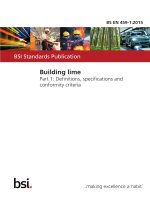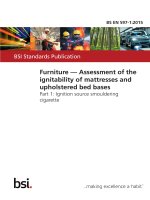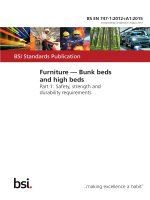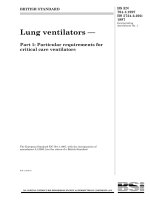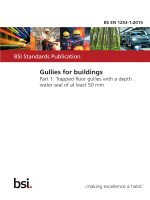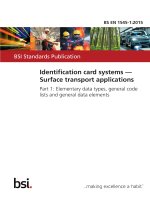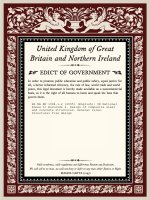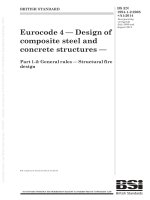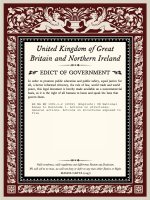Bsi bs en 62343 1 2 2015
Bạn đang xem bản rút gọn của tài liệu. Xem và tải ngay bản đầy đủ của tài liệu tại đây (1.31 MB, 18 trang )
BS EN 62343-1-2:2015
BSI Standards Publication
Dynamic modules
Part 1-2: Performance standards —
Tuneable chromatic dispersion compensator
(non-connectorized)
BRITISH STANDARD
BS EN 62343-1-2:2015
National foreword
This British Standard is the UK implementation of EN 62343-1-2:2015. It is
identical to IEC 62343-1-2:2015. It supersedes BS EN 62343-1-2:2008 which
is withdrawn.
The UK participation in its preparation was entrusted by Technical
Committee GEL/86, Fibre optics, to Subcommittee GEL/86/3, Fibre optic
systems and active devices.
A list of organizations represented on this committee can be obtained on
request to its secretary.
This publication does not purport to include all the necessary provisions of
a contract. Users are responsible for its correct application.
© The British Standards Institution 2015.
Published by BSI Standards Limited 2015
ISBN 978 0 580 85513 9
ICS 33.180.30
Compliance with a British Standard cannot confer immunity from
legal obligations.
This British Standard was published under the authority of the
Standards Policy and Strategy Committee on 31 December 2015.
Amendments/corrigenda issued since publication
Date
Text affected
BS EN 62343-1-2:2015
EN 62343-1-2
EUROPEAN STANDARD
NORME EUROPÉENNE
EUROPÄISCHE NORM
November 2015
ICS 33.180.30
Supersedes EN 62343-1-2:2008
English Version
Dynamic modules - Part 1-2: Performance standards Tuneable chromatic dispersion compensator
(non-connectorized)
(IEC 62343-1-2:2015)
Modules dynamiques - Partie 1-2: Normes de performance Compensateur de dispersion chromatique réglable
(non connectorisé)
(IEC 62343-1-2:2015)
Dynamische Module - Teil 1-2: Betriebsverhaltensnormen Einstellbarer Kompensator für chromatische Dispersion
(nicht mit Steckern versehen)
(IEC 62343-1-2:2015)
This European Standard was approved by CENELEC on 2015-07-30. CENELEC members are bound to comply with the CEN/CENELEC
Internal Regulations which stipulate the conditions for giving this European Standard the status of a national standard without any alteration.
Up-to-date lists and bibliographical references concerning such national standards may be obtained on application to the CEN-CENELEC
Management Centre or to any CENELEC member.
This European Standard exists in three official versions (English, French, German). A version in any other language made by translation
under the responsibility of a CENELEC member into its own language and notified to the CEN-CENELEC Management Centre has the
same status as the official versions.
CENELEC members are the national electrotechnical committees of Austria, Belgium, Bulgaria, Croatia, Cyprus, the Czech Republic,
Denmark, Estonia, Finland, Former Yugoslav Republic of Macedonia, France, Germany, Greece, Hungary, Iceland, Ireland, Italy, Latvia,
Lithuania, Luxembourg, Malta, the Netherlands, Norway, Poland, Portugal, Romania, Slovakia, Slovenia, Spain, Sweden, Switzerland,
Turkey and the United Kingdom.
European Committee for Electrotechnical Standardization
Comité Européen de Normalisation Electrotechnique
Europäisches Komitee für Elektrotechnische Normung
CEN-CENELEC Management Centre: Avenue Marnix 17, B-1000 Brussels
© 2015 CENELEC All rights of exploitation in any form and by any means reserved worldwide for CENELEC Members.
Ref. No. EN 62343-1-2:2015 E
BS EN 62343-1-2:2015
EN 62343-1-2:2015
European foreword
The text of document 86C/1315/FDIS, future edition 2 of IEC 62343-1-2, prepared by SC 86C "Fibre
optic systems and active devices” of IEC/TC 86 “Fibre optics" was submitted to the IEC-CENELEC
parallel vote and approved by CENELEC as EN 62343-1-2:2015.
The following dates are fixed:
•
latest date by which the document has to be
implemented at national level by
publication of an identical national
standard or by endorsement
(dop)
2016-05-27
•
latest date by which the national
standards conflicting with the
document have to be withdrawn
(dow)
2018-07-30
This document supersedes EN 62343-1-2:2008. It constitutes a technical revision. This edition
includes the following significant technical changes with respect to the previous edition:
a) substantial addition of definitions and removal of type C performances.
b) change in the title to reflect standard terminology.
Attention is drawn to the possibility that some of the elements of this document may be the subject of
patent rights. CENELEC [and/or CEN] shall not be held responsible for identifying any or all such
patent rights.
Endorsement notice
The text of the International Standard IEC 62343-1-2:2015 was approved by CENELEC as a
European Standard without any modification.
In the official version, for Bibliography, the following notes have to be added for the standards indicated:
1)
2
1)
IEC 62343-1
NOTE
Harmonized as EN 62343-1 .
IEC 62343-1-3
NOTE
Harmonized as EN 62343-1-3.
At draft stage.
BS EN 62343-1-2:2015
EN 62343-1-2:2015
Annex ZA
(normative)
Normative references to international publications
with their corresponding European publications
The following documents, in whole or in part, are normatively referenced in this document and are
indispensable for its application. For dated references, only the edition cited applies. For undated
references, the latest edition of the referenced document (including any amendments) applies.
NOTE 1 When an International Publication has been modified by common modifications, indicated by (mod), the relevant
EN/HD applies.
NOTE 2 Up-to-date information on the latest versions of the European Standards listed in this annex is available here:
www.cenelec.eu
Publication
Year
Title
EN/HD
Year
IEC 61300-1
-
Fibre optic interconnecting devices and
passive components - Basic test and
measurement procedures Part 1: General and guidance
EN 61300-1
-
IEC 61300-2-14
-
Fibre optic interconnecting devices and
passive components - Basic test and
measurement procedures Part 2-14: Tests - High optical power
EN 61300-2-14
-
IEC 61300-3-2
-
Fibre optic interconnecting devices and
EN 61300-3-2
passive components - Basic test and
measurement procedures Part 3-2: Examinations and measurements
- Polarization dependent loss in a singlemode fibre optic device
-
IEC 61300-3-29
-
Fibre optic interconnecting devices and
passive components - Basic test and
measurement procedures Part 3-29: Examinations and
measurements - Spectral transfer
characteristics of DWDM devices
EN 61300-3-29
-
IEC 61300-3-32
-
Fibre optic interconnecting devices and
passive components - Basic test and
measurement procedures Part 3-32: Examinations and
measurements - Polarisation mode
dispersion measurement for passive
optical components
EN 61300-3-32
-
IEC 61300-3-38
-
Fibre optic interconnecting devices and
passive components - Basic test and
measurement procedures Part 3-38:Examinations and
measurements - Group delay, chromatic
dispersion and phase ripple
EN 61300-3-38
-
3
BS EN 62343-1-2:2015
EN 62343-1-2:2015
Publication
Year
Title
EN/HD
Year
IEC 61753-021-2
-
Fibre optic interconnecting devices
and passive components performance
standard Part 021-2: Grade C/3 single-mode fibre
optic connectors for category C Controlled environment
EN 61753-021-2
-
IEC 62074-1
-
Fibre optic interconnecting devices and
passive components - Fibre optic WDM
devices Part 1: Generic specification
EN 62074-1
-
IEC 62343
-
Dynamic modules - General and guidance EN 62343
-
ITU-T
Recommendation
G.671
-
Transmission characteristics of optical
components and subsystems
-
-
ITU-T
Recommendation
G.692
-
Optical interfaces for multichannel systems with optical amplifiers
-
Optical system design and engineering
considerations
-
ITU-T G-series
Recommendations Supplement 39
4
-
–2–
BS EN 62343-1-2:2015
IEC 62343-1-2:2015 © IEC 2015
CONTENTS
FOREWORD ......................................................................................................................... 3
1
Scope ............................................................................................................................ 5
2
Normative references..................................................................................................... 5
3
Terms and definitions .................................................................................................... 6
4
Test .............................................................................................................................. 7
4.1
4.2
4.3
5
Test
6
General ................................................................................................................. 7
Module .................................................................................................................. 7
Spectral bands ...................................................................................................... 7
report..................................................................................................................... 8
Performance requirements ............................................................................................. 8
6.1
Dimensions ........................................................................................................... 8
6.2
Sample size .......................................................................................................... 8
6.3
Test details and requirements ................................................................................ 8
Bibliography ....................................................................................................................... 11
Table 1 – Spectral bands for single-mode systems (ITU-T G Suppl. 39) ................................. 8
Table 2 – Test and requirements for type A (Multi/single channel type TDC with large
dispersion variable range) ..................................................................................................... 9
Table 3 – Test and requirements for type B (Multi/single channel type TDC with
standard dispersion variable range) ..................................................................................... 10
BS EN 62343-1-2:2015
IEC 62343-1-2:2015 © IEC 2015
–3–
INTERNATIONAL ELECTROTECHNICAL COMMISSION
____________
DYNAMIC MODULES –
Part 1-2: Performance standards – Tuneable chromatic
dispersion compensator (non-connectorized)
FOREWORD
1) The International Electrotechnical Commission (IEC) is a worldwide organization for standardization comprising
all national electrotechnical committees (IEC National Committees). The object of IEC is to promote
international co-operation on all questions concerning standardization in the electrical and electronic fields. To
this end and in addition to other activities, IEC publishes International Standards, Technical Specifications,
Technical Reports, Publicly Available Specifications (PAS) and Guides (hereafter referred to as “IEC
Publication(s)”). Their preparation is entrusted to technical committees; any IEC National Committee interested
in the subject dealt with may participate in this preparatory work. International, governmental and nongovernmental organizations liaising with the IEC also participate in this preparation. IEC collaborates closely
with the International Organization for Standardization (ISO) in accordance with conditions determined by
agreement between the two organizations.
2) The formal decisions or agreements of IEC on technical matters express, as nearly as possible, an international
consensus of opinion on the relevant subjects since each technical committee has representation from all
interested IEC National Committees.
3) IEC Publications have the form of recommendations for international use and are accepted by IEC National
Committees in that sense. While all reasonable efforts are made to ensure that the technical content of IEC
Publications is accurate, IEC cannot be held responsible for the way in which they are used or for any
misinterpretation by any end user.
4) In order to promote international uniformity, IEC National Committees undertake to apply IEC Publications
transparently to the maximum extent possible in their national and regional publications. Any divergence
between any IEC Publication and the corresponding national or regional publication shall be clearly indicated in
the latter.
5) IEC itself does not provide any attestation of conformity. Independent certification bodies provide conformity
assessment services and, in some areas, access to IEC marks of conformity. IEC is not responsible for any
services carried out by independent certification bodies.
6) All users should ensure that they have the latest edition of this publication.
7) No liability shall attach to IEC or its directors, employees, servants or agents including individual experts and
members of its technical committees and IEC National Committees for any personal injury, property damage or
other damage of any nature whatsoever, whether direct or indirect, or for costs (including legal fees) and
expenses arising out of the publication, use of, or reliance upon, this IEC Publication or any other IEC
Publications.
8) Attention is drawn to the Normative references cited in this publication. Use of the referenced publications is
indispensable for the correct application of this publication.
9) Attention is drawn to the possibility that some of the elements of this IEC Publication may be the subject of
patent rights. IEC shall not be held responsible for identifying any or all such patent rights.
International Standard IEC 62343-1-2 has been prepared by subcommittee 86C: Fibre optic
systems and active devices, of IEC technical committee 86: Fibre optics.
This second edition cancels and replaces the first edition published in 2007. It constitutes a
technical revision.
This edition includes the following significant technical changes with respect to the previous
edition:
a) substantial addition of definitions and removal of type C performances.
b) change in the title to reflect standard terminology.
–4–
BS EN 62343-1-2:2015
IEC 62343-1-2:2015 © IEC 2015
The text of this standard is based on the following documents:
FDIS
Report on voting
86C/1315/FDIS
86C/1336/RVD
Full information on the voting for the approval of this standard can be found in the report on
voting indicated in the above table.
This publication has been drafted in accordance with the ISO/IEC Directives, Part 2.
A list of all parts in the IEC 62343 series, published under the general title Dynamic modules,
can be found on the IEC website.
The committee has decided that the contents of this publication will remain unchanged until
the stability date indicated on the IEC web site under "" in the data
related to the specific publication. At this date, the publication will be
•
reconfirmed,
•
withdrawn,
•
replaced by a revised edition, or
•
amended.
BS EN 62343-1-2:2015
IEC 62343-1-2:2015 © IEC 2015
–5–
DYNAMIC MODULES –
Part 1-2: Performance standards – Tuneable chromatic
dispersion compensator (non-connectorized)
1
Scope
This part of IEC 62343 contains the recommended minimum initialization test and
measurement requirements and severities for optical tuneable chromatic dispersion
compensators (TDC).
2
Normative references
The following documents, in whole or in part, are normatively referenced in this document and
are indispensable for its application. For dated references, only the edition cited applies. For
undated references, the latest edition of the referenced document (including any
amendments) applies.
IEC 61300-1, Fibre optic interconnecting devices and passive components – Basic test and
measurement procedures – Part 1: General and guidance
IEC 61300-2-14, Fibre optic interconnecting devices and passive components – Basic test
and measurement procedures – Part 2-14: Tests – High optical power
IEC 61300-3-2, Fibre optic interconnecting devices and passive components – Basic test and
measurement procedures – Part 3-2: Examination and measurements – Polarization
dependent loss in a single-mode fibre optic device
IEC 61300-3-29, Fibre optic interconnecting devices and passive components – Basic test
and measurement procedures – Part 3-29: Examinations and measurements – Spectral
transfer characteristics of DWDM devices
IEC 61300-3-32, Fibre optic interconnecting devices and passive components – Basic test
and measurement procedures – Part 3-32: Examinations and measurements – Polarization
mode dispersion measurement for passive optical components
IEC 61300-3-38, Fibre optic interconnecting devices and passive components – Basic test
and measurement procedures – Part 3-38: Examinations and measurements – Group delay,
chromatic dispersion and phase ripple
IEC 61753-021-2, Fibre optic interconnecting devices and passive components performance
standard – Part 021-2: Grade C/3 single-mode fibre optic connectors for category C –
Controlled environment
IEC 62074-1, Fibre optic interconnecting devices and passive components – Fibre optic WDM
devices – Part 1: Generic specification
IEC 62343, Dynamic modules – General and guidance
ITU-T Recommendation G.671, Transmission characteristics of optical components and
subsystems
–6–
BS EN 62343-1-2:2015
IEC 62343-1-2:2015 © IEC 2015
ITU-T Recommendation G.692, Optical interfaces for multichannel systems with optical
amplifiers
ITU-T G-series Recommendations – Supplement 39, Optical system design and engineering
considerations
3
Terms and definitions
For the purposes of this document, the terms and definitions given in IEC 62074-1, IEC 62343
and the following apply.
3.1
group delay
time required by an optical pulse to transit an optical element
Note 1 to entry: Group delay that depends on optical wavelength (or frequencies) causes optical pulse distortion
through the optical element.
Note 2 to entry: It is expressed as the derivation of the propagation constant with respect to angular frequency,
∂β/∂ω, through the optical element, where β is the propagation constant, and ω is the angular frequency equal to
2πc/λ, where λ is the wavelength.
3.2
GDR
group delay ripple
maximum peak-to-peak variation of the group delay approximated by a desired function,
typically a linear fit, within a channel wavelength (or frequency) range
Note 1 to entry This note applies to the French languange only.
3.3
phase ripple
standard deviation of the peak-to-peak variation in measured phase spectrum when compared
to a quadratic fit within a channel wavelength (or frequencies) range
3.4
CD
chromatic dispersion
group delay difference between two closely spaced wavelengths inside an optical signal going
through a pair of conducting ports of a DWDM device
Note 1 to entry: It corresponds to the difference between the arrival times of these two closely spaced
wavelengths. Chromatic dispersion is defined as the variation (first order derivative) of this group delay over a
range of wavelengths especially over the channel operating wavelength range at the given time, temperature,
pressure and humidity. It is expressed in terms of units of ps/nm or ps/GHz and it is a predictor of the broadening
of a pulse transmitted through the module.
Note 2 to entry: This note applies to the French languange only.
3.5
tuneable chromatic dispersion compensator
two-port in-line device that is capable of transforming, by internal or external automatic
control, an input signal with time-varying dispersion into an output signal in which an output
channel dispersion value is set for a required level of value
3.6
operating wavelength range
specified range of wavelengths from λ imin to λ imax about a nominal operating wavelength λ I ,
within which a dynamic optical module is designed to operate with a specified performance
BS EN 62343-1-2:2015
IEC 62343-1-2:2015 © IEC 2015
–7–
3.7
channel frequency range
frequency range within which a device is expected to operate with a specified performance
Note 1 to entry: For a particular nominal channel central frequency, f nomi , this frequency range is from
f imin = (f nomi − ∆f max ) to f imax = (f nomi + ∆f max ), where ∆f max is the maximum channel central frequency deviation.
3.8
passband ripple
maximum peak-to-peak variation of the insertion loss within a channel frequency (or
wavelength) range
3.9
channel spacing
centre to centre difference in frequency (or wavelength) between adjacent channels in a
device
4
4.1
Test
General
The characterization of a tuneable chromatic dispersion compensator requires demonstration
that those components or features within the module, together with that of the module itself,
are capable of yielding the performance requirements as defined in the relevant specification.
Where it can be adequately demonstrated that components or features have previously met
all of the requirements of a specific performance standard category, they may be declared as
complying with that performance standard. This may obviate the need for repeat testing of
components or features in such cases. Where this occurs, reference shall be made to the
relevant test reports or documentation.
4.2
Module
Unless otherwise specified, all TDC module test methods shall be in accordance with
IEC 61300-1, IEC 61300-2-14, IEC 61300-3-2, IEC 61300-3-29, IEC 61300-3-32 and
IEC 61300-3-38.
TDC modules used for each test are intended to be previously unstressed new samples but
may be selected from previously used samples if desired. Each test defines the number of
samples to be evaluated.
All measurements shall be carried out at standard test conditions as defined in IEC 61300-1,
unless otherwise stated. If the module is provided with an active temperature control, this
shall be set at the setpoint specified by the manufacturer.
The defined performance requirements apply to every combination of input and output port,
over all polarization states and over all specified environmental conditions.
4.3
Spectral bands
All tests shall be carried out to validate performance over the required operating wavelength
range. As a result, single or multiple spectral bands may be chosen for the qualification, and
differing target specifications may be assigned to each spectral band.
Table 1 is intended to provide guidance on the wavelength ranges of the various spectral
bands. It is not intended for specification. Values of operating wavelength used in
performance verification shall be specified between the customer and supplier or shall be as
defined in the manufacturer’s specification.
–8–
BS EN 62343-1-2:2015
IEC 62343-1-2:2015 © IEC 2015
Table 1 – Spectral bands for single-mode systems (ITU-T G Suppl. 39)
Band
5
Range
(nm)
Descriptor
O-band
Original
1 260 to 1 360
E-band
Extended
1 360 to 1 460
S-band
Short wavelength
1 460 to 1 530
C-band
Conventional
1 530 to 1 565
L-band
Long wavelength
1 565 to 1 625
U-band
Ultralong wavelength
1 625 to 1 675
Test report
Fully documented test reports and supporting evidence shall be prepared and be available for
inspections as evidence that the tests have been carried out and complied with.
6
6.1
Performance requirements
Dimensions
Dimensions shall comply with either an appropriate IEC interface standard, or with those
given in the manufacturer's drawings when the IEC interface standard does not exist or
cannot be used.
6.2
Sample size
Three (3) TDC modules are used in each module test. The tests may be performed
individually or in sequential order.
The test sample size and sequencing requirements for the modules shall be defined in the
relevant specification.
6.3
Test details and requirements
The requirements are given only for non-connectorized TDC modules. For connectorized
modules, the connector performances shall be in compliance with IEC 61753-021-2.
A minimum length of fibre or cable of 1,5 m per port shall be included in all climatic and
environmental tests.
The channel spacings, unless
ITUT Recommendation G.692.
otherwise
specified,
shall
be
in
accordance
with
The test details of the performance standard are shown in Tables 2 and 3. These tables
provide figures as a guideline of performance requirements and are not indicative of values
that must be met in an operational environment.
BS EN 62343-1-2:2015
IEC 62343-1-2:2015 © IEC 2015
–9–
Table 2 – Test and requirements for type A
(Multi/single channel type TDC with large dispersion variable range)
No
1A
Tests
Channel frequency range
Requirements
Details
(ITU-T-grid) ±10 GHz (for 10 Gb/s) ITU-T Recommendation G.671
(ITU-T-grid) ±40 GHz (for 40 Gb/s)
2A
Dispersion variable range
–1 800 to +1 800 ps/nm (for
10 Gb/s)
IEC 61300-3-38
–400 to +400 (for 40 Gb/s)
3A
Insertion loss
≤ 12 dB
IEC 61300-3-29
4A
Passband ripple
< 0,5 dB
IEC 61300-3-29
over the channel frequency range
5A
Group delay ripple
≤ ±6 ps (for 10 Gb/s)
IEC 61300-3-38
≤ ±2 ps (for 40 Gb/s)
6A
Phase ripple
< 0,046 rad (eye opening
penalty = 0,1 dB)
IEC 61300-3-38
7A
Polarization dependent loss
≤ 0,6 dB
IEC 61300-3-2
over the channel frequency range
8A
Inter-channel loss uniformity
≤ 0,85 dB (only multi-channel
type )
IEC 61300-3-29
9A
Polarization mode dispersion
≤ 3 ps (for 10 Gb/s)
IEC 61300-3-32
≤ 1 ps (for 40 Gb/s)
10A
Dispersion setting error
≤ ±5 ps/nm
IEC 61300-3-38
11A
Dispersion tuning time
≤ 30 s
Method under consideration
12A
Power consumption
≤ 10 W
Method under consideration
13A
High optical power
+23 dBm
IEC 61300-2-14
– 10 –
BS EN 62343-1-2:2015
IEC 62343-1-2:2015 © IEC 2015
Table 3 – Test and requirements for type B
(Multi/single channel type TDC with standard dispersion variable range)
No
1B
Tests
Channel frequency range
Requirements
Details
(ITU-T-grid) ±10 GHz (for 10 Gb/s) ITU-T Recommendation G.671
(ITU-T-grid) ±40 GHz (for 40 Gb/s)
2B
Dispersion variable range
Nominal ±400 ps/nm (for 10 Gb/s) IEC 61300-3-38
Nominal ±100 ps/nm (for 40 Gb/s)
3B
Insertion loss
≤ 4 dB
IEC 61300-3-29
4B
Passband ripple
< 0,5 dB
IEC 61300-3-29
over the channel frequency range
5B
Group delay ripple
≤ ±6 ps (for 10 Gb/s)
IEC 61300-3-38
≤ ±2 ps (for 40 Gb/s)
6B
Phase ripple
< 0,046 rad (eye opening
penalty = 0,1 dB)
IEC 61300-3-38
7B
Polarization dependent loss
≤ 0,6 dB
IEC 61300-3-2
over the channel frequency range
8B
Inter-channel loss uniformity
≤ 0,85 dB (only multi-channel
type )
IEC 61300-3-29
9B
Polarization mode dispersion
≤ 3 ps (for 10 Gb/s)
IEC 61300-3-32
≤ 1 ps (for 40 Gb/s)
10B
Dispersion setting error
≤ ±5 ps/nm
IEC 61300-3-38
11B
Dispersion tuning time
≤ 30 s
Method under consideration
12B
Power consumption
≤ 10 W
Method under consideration
13B
Optical power handling and
+23 dBm
damage threshold characterization
IEC 61300-2-14
BS EN 62343-1-2:2015
IEC 62343-1-2:2015 © IEC 2015
– 11 –
Bibliography
IEC 62343-1, Dynamic modules – Performance standards – General conditions 1
IEC 62343-1-3, Dynamic modules – Part 1-3: Performance standards – Dynamic gain tilt
equalizer (non-connectorized)
ITU-T Recommendation G.694.1, Spectral grids for WDM applications: DWDM frequency grid
___________
___________
1
To be published
This page deliberately left blank
NO COPYING WITHOUT BSI PERMISSION EXCEPT AS PERMITTED BY COPYRIGHT LAW
British Standards Institution (BSI)
BSI is the national body responsible for preparing British Standards and other
standards-related publications, information and services.
BSI is incorporated by Royal Charter. British Standards and other standardization
products are published by BSI Standards Limited.
About us
Revisions
We bring together business, industry, government, consumers, innovators
and others to shape their combined experience and expertise into standards
-based solutions.
Our British Standards and other publications are updated by amendment or revision.
The knowledge embodied in our standards has been carefully assembled in
a dependable format and refined through our open consultation process.
Organizations of all sizes and across all sectors choose standards to help
them achieve their goals.
Information on standards
We can provide you with the knowledge that your organization needs
to succeed. Find out more about British Standards by visiting our website at
bsigroup.com/standards or contacting our Customer Services team or
Knowledge Centre.
Buying standards
You can buy and download PDF versions of BSI publications, including British
and adopted European and international standards, through our website at
bsigroup.com/shop, where hard copies can also be purchased.
If you need international and foreign standards from other Standards Development
Organizations, hard copies can be ordered from our Customer Services team.
Subscriptions
Our range of subscription services are designed to make using standards
easier for you. For further information on our subscription products go to
bsigroup.com/subscriptions.
With British Standards Online (BSOL) you’ll have instant access to over 55,000
British and adopted European and international standards from your desktop.
It’s available 24/7 and is refreshed daily so you’ll always be up to date.
You can keep in touch with standards developments and receive substantial
discounts on the purchase price of standards, both in single copy and subscription
format, by becoming a BSI Subscribing Member.
PLUS is an updating service exclusive to BSI Subscribing Members. You will
automatically receive the latest hard copy of your standards when they’re
revised or replaced.
To find out more about becoming a BSI Subscribing Member and the benefits
of membership, please visit bsigroup.com/shop.
With a Multi-User Network Licence (MUNL) you are able to host standards
publications on your intranet. Licences can cover as few or as many users as you
wish. With updates supplied as soon as they’re available, you can be sure your
documentation is current. For further information, email
BSI Group Headquarters
389 Chiswick High Road London W4 4AL UK
We continually improve the quality of our products and services to benefit your
business. If you find an inaccuracy or ambiguity within a British Standard or other
BSI publication please inform the Knowledge Centre.
Copyright
All the data, software and documentation set out in all British Standards and
other BSI publications are the property of and copyrighted by BSI, or some person
or entity that owns copyright in the information used (such as the international
standardization bodies) and has formally licensed such information to BSI for
commercial publication and use. Except as permitted under the Copyright, Designs
and Patents Act 1988 no extract may be reproduced, stored in a retrieval system
or transmitted in any form or by any means – electronic, photocopying, recording
or otherwise – without prior written permission from BSI. Details and advice can
be obtained from the Copyright & Licensing Department.
Useful Contacts:
Customer Services
Tel: +44 845 086 9001
Email (orders):
Email (enquiries):
Subscriptions
Tel: +44 845 086 9001
Email:
Knowledge Centre
Tel: +44 20 8996 7004
Email:
Copyright & Licensing
Tel: +44 20 8996 7070
Email:
